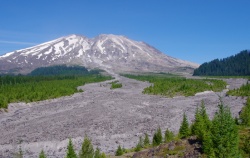Ape Canyon Hike
From Oregon Hikers Field Guide
- Start point: Ape Canyon Trailhead
- End Point: Ape Canyon Viewpoint
- Trail Log:
- Hike Type: Out and Back
- Distance: 11.0 miles round-trip
- Elevation gain: 2,485 feet
- High Point: 4,315 feet
- Difficulty: Moderate
- Seasons: Mid-summer through Fall
- Family Friendly: No
- Backpackable: Yes: connects to Loowit Trail
- Crowded: Yes; trail is popular with both hikers and mountain bikers
Contents |
Description
The dusty Ape Canyon Trail #234 heads into a forest of Douglas-fir, western red-cedar, western hemlock, and silver fir. Soon, however, the path passes through an old clearcut regenerating with Sitka alder and assorted conifers. A spur leads left to a view up the Muddy River Lahar and the southeast face of Mount Saint Helens. This is the first of many such viewpoints as you gradually ascend this ridge, sometimes dipping into lush draws and then rising again.
After about 1 ½ miles, the trail enters cool, shady old growth forest dominated by Douglas-fir, western hemlock, noble fir, and silver fir. On a hot day, the temperature difference between the old growth and the brushy clearings is noticeable. The trail makes four switchbacks, swinging between the west and east slopes of the ridge. After a rising traverse, the path switchbacks again to the east side and heads up a brushy alley of Sitka alder and vine maple. Then, you drop over to the west slope and get another view of the Muddy Fork and the slopes of Mount Saint Helens all the way to the Worm Flows. The trail enters a wonderful old growth noble fir grove rising out of a vanilla leaf carpet and heads up the ridge again. On the right, you will pass one of the most massive silver firs you will ever see. A view just past here extends to Mount Rainier and Mount Adams, Indian Heaven, and the Smith Creek drainage far below. After switchbacking, the trail reaches the west slope of the ridge for a full frontal view of the lahar and mountain. Then, heading over to the east side, you will see Pumice Butte and the waterfall that splashes over a rim into Ape Creek’s slot canyon. The trail passes through another alder thicket and emerges into the 1980 blast zone.
A spectacular viewpoint looks out over a sheer-sided notch that carries snowmelt into Ape Canyon. To the left, a spur trail leads to views over the Muddy River Lahar and south to Mount Hood. Seismic equipment mounted here monitors the moods of the mountain. Soon, you reach the Ape Canyon-Loowit Trail Junction and turn right. In the early morning or evening hours, watch for mountain goats and hoary marmots in this area.
The rubbly path drops and crosses several gullies before rising to the south edge of the pumice flatland known as the Plains of Abraham. Pyroclastic “bombs” dot the surface. You will pass two large cairns and descend along the lush course of Ape Creek. This area is blooming with lupine, paintbrush, and arnica into mid-summer. There are two viewpoints south and north of Ape Creek where it tumbles down a lip into the canyon. Mount Adams and Mount Hood are both visible, as is the entire ridge of Indian Heaven. The spot is framed by a grassy knoll strewn with the skeletons of blasted trees to the left and the sere slopes of Pumice Butte to the right.
Fees, Regulations, etc.
- Northwest Forest Pass required
Maps
- Green Trails Maps: Mount St. Helens, WA #364
- U.S. Department of Agriculture, Forest Service: Mount St. Helens National Volcanic Monument & Administrative Area
- U.S. Department of Agriculture, Forest Service: Gifford Pinchot National Forest
Trip Reports
- Search Trip Reports for Ape Canyon Hike
- Mt. Saint Helens - Ape Canyon and Around
- Wildflowers and Mountains along Ape Canyon Hike
- Ape Canyon Trail #234 (July 2-3, 2011)
Related Discussions / Q&A
- Search Trail Q&A for Ape Canyon Hike
Guidebooks that cover this hike
Best Old-growth Forest Hikes: Washington & Oregon Cascades by John & Diane Cissel
100 Hikes in Northwest Oregon and Southwest Washington by William L. Sullivan
60 Hikes Within 60 Miles: Portland by Paul Gerald
Day Hiking: South Cascades by Dan A. Nelson and Alan L. Bauer
Take a Hike: Portland by Barbara I. Bond
More Links
- Ape Canyon and the Plains of Abraham Hike (Northwest Hiker)
- Ape Canyon (Washington Trails Association)
- Ape Canyon Trail #234 (USFS)
- Trail: Ape Canyon (Evergreen Mountain Bike Alliance)
Page Contributors
- bobcat (primary)







